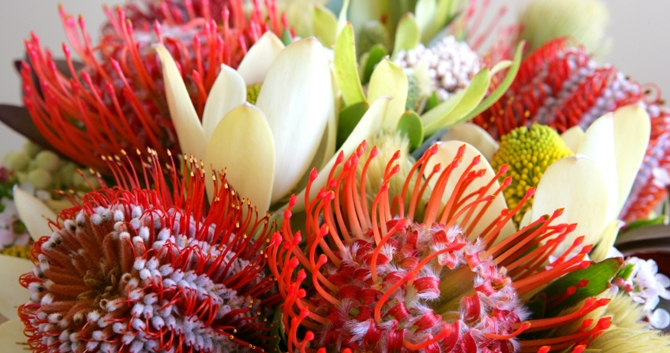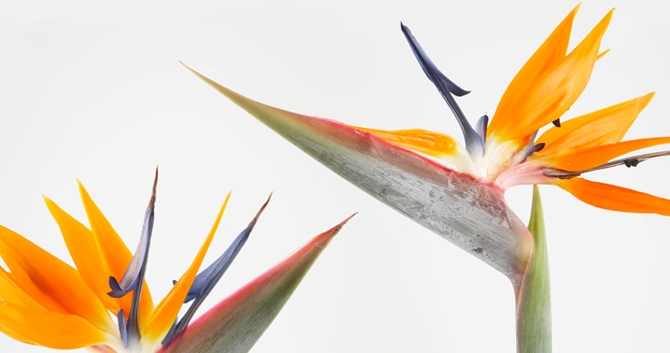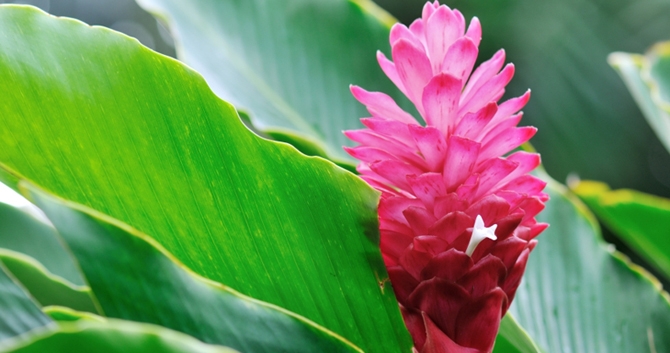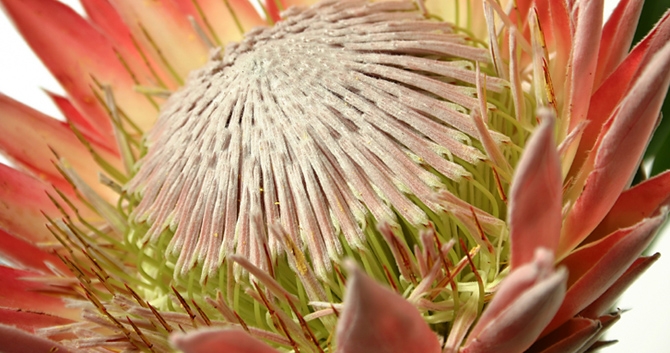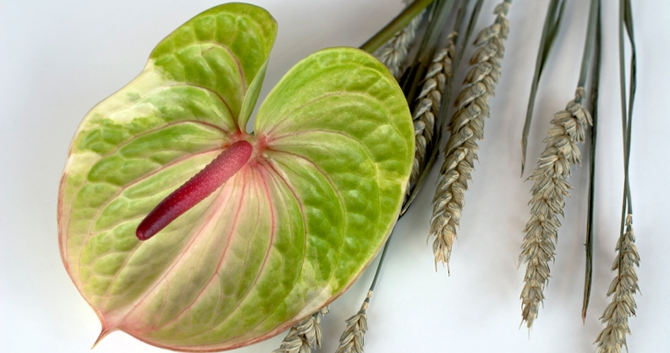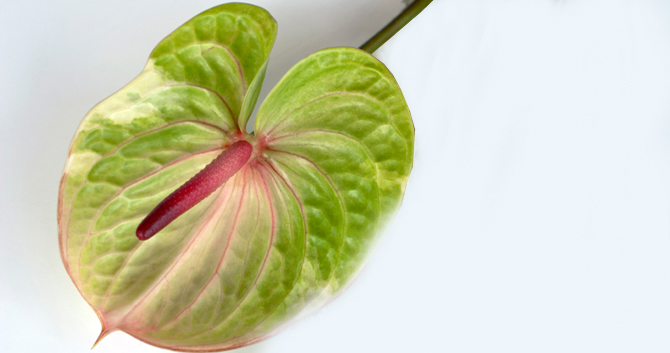Care Tips:Â
With proper care, your tropical flowers should last 7 to 21 days, depending on the variety (see sidebar). To ensure they remain healthy and vibrant for as long as possible, follow these few simple care tips:
- Some tropical flowers have a dusting of white powder that should be washed away before you start. For anthuriums and gingers, simply submerge the heads in water to rinse away the unsightly powder. For heliconias, sponge them with a mixture of soap and a few drops of vegetable oil, and then rinse with fresh water.Â
- Once they’re cleaned and ready, fill a vase with warm water and allow it to come to room temperature. Be sure the vase is heavy and sturdy so it won’t tip over. If you’re using floral foam, let it soak until it is fully saturated and sinks to the bottom.
- Add a packet of flower preservative to the water to extend the bloom life and prevent bacteria. If you don’t have flower food, dissolve half a teaspoon of sugar, a teaspoon of lemon juice, and a few drops of bleach in 4 cups of water to create a home-made substitute.
- Keeping the stems under water, slant cut 1†from the bottom to help them take in the fresh clean water and extend the blooms.
- Remove any foliage that will become submerged to prevent rotting.Â
- Arrange the stems to your liking, varying the height and position. Once your tropical flowers are positioned, add other flowers and foliage to the arrangement.
- Replace the water every three days or when it begins to look cloudy – this helps prevent the stems from clogging and improves water uptake.
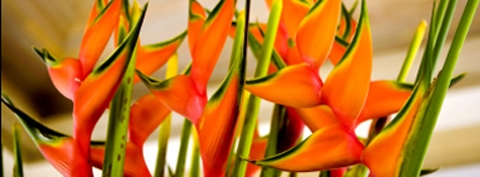 Heliconia symbolizes great returns
Heliconia symbolizes great returns
About Tropical Flowers:
Between the Tropic of Cancer and the Tropic of Capricorn lie “the tropicsâ€, a lush green ring encircling the earth where exotic flowers grow up to four feet tall with blooms in all colors, shapes, and sizes. Competing to attract the attention of hummingbirds, butterflies, and other pollinators in dense sultry rainforests, these exquisite flowers have also succeeded in attracting our attention as a way to add beauty to a room and set the mood for an event.Â
Surprisingly, many of the most popular tropical flowers are scientifically related. For example, bird-of-paradise, heliconia, and ginger are all members of the Zingiberales order of plants, which also includes bananas, prayer plants, and canna. What we think of as their flowers, are actually protective bracts that cradle the true flowers inside.Â
Bird-of-paradise
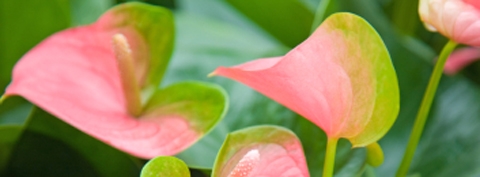 In addition to red, Anturiums come in white, pink, peach, magenta, and green
In addition to red, Anturiums come in white, pink, peach, magenta, and green
(Also known as crane flower): Inspired by their royal blue and bright orange flowers fanning from green bracts like a colorful bird in flight, bird-of-paradise flowers have come to symbolize freedom and magnificence. Native to South Africa, these exotic flowers typically have three to five “birds†inside each bract that bloom in succession, fluttering above the other blooms in your arrangement.Â
Every now and then you might get a few birds that are reluctant to emerge. If this happens, simply spread the bract and gently pull them out. If the bracts are tightly closed, soak in warm water for 20 minutes, cut a slit where they attach to the stem, gently pull out the flowers, and remove the thin white membrane that separates each flower.Â
Heliconia
(Also known as false bird-of-paradise), lobster claw, parrot flowers, and wild plantain, has large vibrant bracts in pink, red, orange, or yellow rising from sturdy towering stalks. Native to Guyana, Costa Rica, Belize, Ecuador, Peru and Brazil, heliconia symbolize great returns. Unlike bird-of-paradise, heliconia has tiny hidden flowers that won’t emerge from the cut stems – their beauty is in color and silhouette of the dramatic bracts.
When selecting heliconia, keep in mind that they don’t develop further once cut, so choose stems with large fully formed bracts. Also be sure to mist occasionally to extend their vase life.Â
Ginger:Â
Native to the Pacific Islands, Malaysia and Taiwan, ornamental gingers have large cone-shaped blooms that symbolize strength and pride. There are several to types of ginger to choose from – some offering bright colors and others adding subtle texture.Â
Torch ginger (also known as ostrich plume or jungle king) gracefully fans out in shades of fuchsia atop tall stems. Pine cone ginger (also known as beehive or shampoo ginger) in taupe and golden yellow has a compact honeycomb shape that lends structure to arrangements and contrast to other flowers.Â
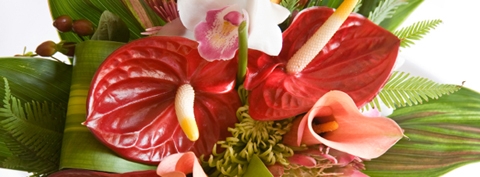 Anthuriums are closely relate to calla lilies - both pair well with orchids and tropical foliage
Anthuriums are closely relate to calla lilies - both pair well with orchids and tropical foliage
Anthurium:Â
With their large open heart shaped face, anthuriums have come to symbolize hospitality and a deep romantic attraction. Originally from Columbia, they were brought to Hawaii in 1889 and have since become virtually synonymous with tropical islands.Â
They’re members of the Araceae family, closely related to calla lilies and philodendron, which share the family resemblance. Although often seen in red with a bright yellow spadix, they’re also available in white, pink, peach, magenta, and green.Â
Protea:
 Proteas are a diverse group on plants name for the Greek God Proteus
Proteas are a diverse group on plants name for the Greek God Proteus
Named for Proteus, the Greek God who could change his form at will, proteas are an extraordinary group of flowers originally found only in South Africa and Australia. Proteas are primitive flowers that date back 300 million years, giving us a glimpse into the past and sparking our imagination.Â
Symbolizing transformation, diversity and courage, they’re available in an array of sizes, shapes, and colors – from pin cushions to imperial crowns in white, yellow, orange, and rose to crimson, magenta, and burgundy. In addition to being excellent fresh flowers, proteas are easy to dry by handing them upside down in a dark place for two to three weeks.
Inspiration:Â
Tropical flowers are a captivating focal point in any room, adding bold color, height, and drama. These large, exotic flowers need little else to effortlessly create a spectacular arrangement - but for those of us who think more is more, try adding banana leaves for fullness, vertical branches or bamboo to accentuate height, or smaller flowers for balance and color. Some of our favorite ways to use these indulgent blooms include:
Romantic: Pine cone ginger, white lilacs, calla lilies, and white peonies are a fragrant and graceful combination.
Vibrant: Red anthuriums, heliconias, and yellow tulips combine contrasting colors for a bright centerpiece.Â
Exotic: For an arrangement with Zen-like harmony, mix Asiatic lilies, alsotroemeria, bird-of-paradise, red hypericum, and bamboo.Â
Sumptuous: Burgundy pin cushion protea, magenta calla lilies and mauve roses are an opulent mix of textures and colors.Â
Bliss: Green anthuriums, magenta orchids, and bird-of-paradise are a combination that transports you to paradise.

